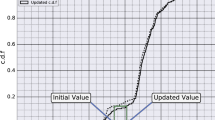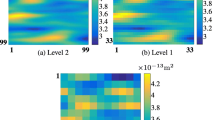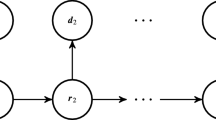Abstract
Assimilation of production data into reservoir models for which the distribution of porosity and permeability is largely controlled by facies has become increasingly common. When the locations of the facies bodies must be conditioned to observations, the truncated plurigaussian model has been often shown to be a useful method for modeling as it allows gaussian variables to be updated instead of facies types. Previous experience has also shown that ensemble Kalman filter-like methods are particularly effective for assimilation of data into truncated plurigaussian models. In this paper, some limitations are shown of the ensemble-based or gradient-based methods when applied to truncated plurigaussian models of a certain type that is likely to occur for modeling channel facies. It is also shown that it is possible to improve the data match and increase the ensemble spread by modifying the updating step using an approximate derivative of the truncation map.























Similar content being viewed by others
References
Adler RJ, Moldavskaya E, Samorodnitsky G (2014) On the existence of paths between points in high level excursion sets of Gaussian random fields. Ann Probab 42(3):1020–1053. https://doi.org/10.1214/12-AOP794
Agbalaka CC, Oliver DS (2008) Application of the EnKF and localization to automatic history matching of facies distribution and production data. Math Geosci 40(4):353–374
Agbalaka CC, Oliver DS (2011) Joint updating of petrophysical properties and discrete facies variables from assimilating production data using the EnKF. SPE J 16(2):318–330. https://doi.org/10.2118/118916-PA
Albertão GA, Grell AP, Badolato D, dos Santos LR (2005) 3D geological modeling in a turbidite system with complex stratigraphic-structural framework—an example from Campos Basin Brazil. In: SPE Annual technical conference and exhibition, Dallas, Texas, 9–12 October, Society of Petroleum Engineers
Armstrong M, Galli A, Beucher H, Le Loc’h G, Renard D, Doligez B, Eschard R, Geffroy F (2011) Plurigaussian simulations in geosciences, 2nd edn. Springer, Berlin. https://doi.org/10.1007/978-3-642-19607-2
Astrakova A, Oliver DS (2015) Conditioning truncated pluri-Gaussian models to facies observations in ensemble-Kalman-based data assimilation. Math Geosci 47(3):345–367. https://doi.org/10.1007/s11004-014-9532-3
Beucher H, Renard D (2016) Truncated Gaussian and derived methods. CR Geosci 348(7):510–519. https://doi.org/10.1016/j.crte.2015.10.004
Biver PYA, Allard D, Pivot F, Ruelland P (2015) Recent advances for facies modelling in pluri-Gaussian formalism. In: Petroleum geostatistics, 7–11 September, Biarritz, France, EAGE
Chen Y (2015) Geologically consistent history matching using the ensemble based methods. In: Petroleum geostatistics, 7–11 September, Biarritz, France, EAGE. https://doi.org/10.3997/2214-4609.201413627
Chen Y, Oliver DS (2010) Cross-covariances and localization for EnKF in multiphase flow data assimilation. Comput Geosci 14:579–601. https://doi.org/10.1007/s10596-009-9174-6
Chen Y, Oliver DS (2012) Ensemble randomized maximum likelihood method as an iterative ensemble smoother. Math Geosci 44(1):1–26. https://doi.org/10.1007/s11004-011-9376-z
Chen Y, Oliver DS (2013) Levenberg–Marquardt forms of the iterative ensemble smoother for efficient history matching and uncertainty quantification. Comput Geosci 17(4):689–703. https://doi.org/10.1007/s10596-013-9351-5
D’Or D, David E, Walgenwitz A, Pluyaud P, Allard D (2017) Non stationary plurigaussian simulations with auto-adaptative truncation diagrams using the CART algorithm. In: 79th EAGE conference and exhibition, Paris, France 12–15 June. https://doi.org/10.3997/2214-4609.201701019
Emerick AA, Reynolds AC (2013) Investigation of the sampling performance of ensemble-based methods with a simple reservoir model. Comput Geosci 17(2):325–350. https://doi.org/10.1007/s10596-012-9333-z
Emery X (2007) Using the Gibbs sampler for conditional simulation of Gaussian-based random fields. Comput Geosci 33(4):522–537. https://doi.org/10.1016/j.cageo.2006.08.003
Evensen G (1994) Sequential data assimilation with a nonlinear quasi-geostrophic model using Monte Carlo methods to forecast error statistics. J Geophys Res 99(C5):10143–10162
Galli A, Le Loc’h G, Geffroy F, Eschard R (2006) An application of the truncated pluri-Gaussian method for modeling geology. In: Coburn TC, Yarus JM, Chambers RI (eds) Stochastic modeling and geostatistics: principles, methods, and case studies, volume II: AAPG computer applications in geology, AAPG special volumes, pp 109–122
Grötsch J, Mercadier C (1999) Integrated 3-D reservoir modeling based on 3-D seismic: the tertiary Malampaya and Camago buildups, offshore Palawan, Philippines. AAPG Bull 83(11):1703–1728
Kitanidis PK (1995) Quasi-linear geostatistical theory for inversing. Water Resour Res 31(10):2411–2419
Le Loc’h G, Galli A (1997) Truncated plurigaussian method: theoretical and practical points of view. In: Baafi EY, Schofield NA (eds) Geostatistics Wollongong ’96, vol 1. Kluwer Academic, Dordrecht, pp 211–222
Liu N, Oliver DS (2004) Automatic history matching of geologic facies. SPE J 9(4):188–195
Liu N, Oliver DS (2005a) Critical evaluation of the ensemble Kalman filter on history matching of geologic facies. SPE Reserv Eval Eng 8(6):470–477. https://doi.org/10.2118/92867-PA
Liu N, Oliver DS (2005b) Ensemble Kalman filter for automatic history matching of geologic facies. J Petrol Sci Eng 47(3–4):147–161
Mariethoz G, Renard P, Cornaton F, Jaquet O (2009) Truncated plurigaussian simulations to characterize aquifer heterogeneity. Ground Water 47(1):13–24. https://doi.org/10.1111/j.1745-6584.2008.00489.x
Oliver DS (2014) Minimization for conditional simulation: relationship to optimal transport. J Comput Phys 265:1–15. https://doi.org/10.1016/j.jcp.2014.01.048
Oliver DS (2017) Metropolized randomized maximum likelihood for improved sampling from multimodal distributions. SIAM/ASA J Uncertain Quantif 5(1):259–277. https://doi.org/10.1137/15M1033320
Oliver DS, He N, Reynolds AC (1996) Conditioning permeability fields to pressure data. In: Proceedings of the European conference on the mathematics of oil recovery, V, pp 1–11
Sebacher B, Hanea R, Heemink A (2013) A probabilistic parametrization for geological uncertainty estimation using the ensemble Kalman filter (EnKF). Comput Geosci 17(5):813–832. https://doi.org/10.1007/s10596-013-9357-z
Zhao Y, Reynolds AC, Li G (2008) Generating facies maps by assimilating production data and seismic data with the ensemble Kalman filter, SPE-113990. In: Proceedings of SPE IOR Symp, Tulsa, OK, April 21–23. https://doi.org/10.2118/113990-MS
Zupanski M, Navon IM, Zupanski D (2008) The maximum likelihood ensemble filter as a non-differentiable minimization algorithm. Q J R Meteorol Soc 134(633):1039–1050. https://doi.org/10.1002/qj.251
Acknowledgements
Primary support for Oliver has been provided by the CIPR/IRIS cooperative research project “4D Seismic History Matching” which is funded by industry partners Eni Norge, Petrobras, and Total, as well as the Research Council of Norway (PETROMAKS2 program). The second author thanks Total for permission to publish this work.
Author information
Authors and Affiliations
Corresponding author
Rights and permissions
About this article
Cite this article
Oliver, D.S., Chen, Y. Data Assimilation in Truncated Plurigaussian Models: Impact of the Truncation Map. Math Geosci 50, 867–893 (2018). https://doi.org/10.1007/s11004-018-9753-y
Received:
Accepted:
Published:
Issue Date:
DOI: https://doi.org/10.1007/s11004-018-9753-y




